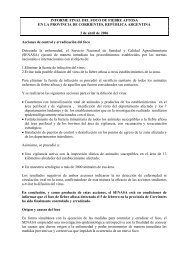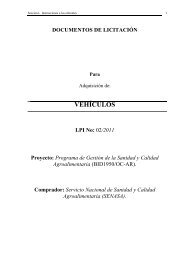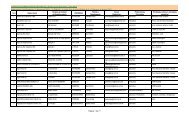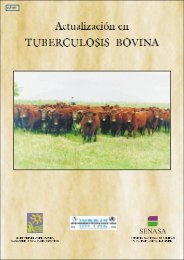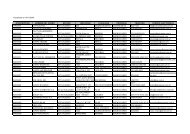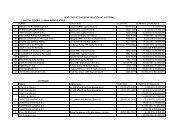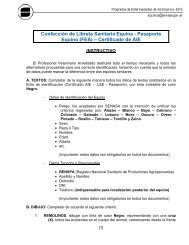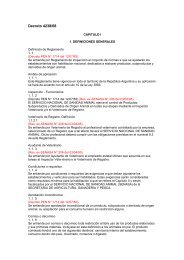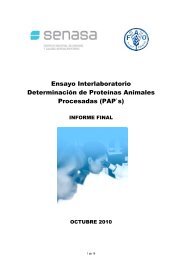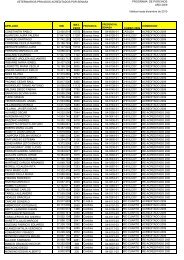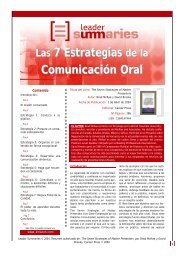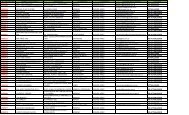PLAN DE TRABAJO PARA LA AUTORIZACION PRE ... - Senasa
PLAN DE TRABAJO PARA LA AUTORIZACION PRE ... - Senasa
PLAN DE TRABAJO PARA LA AUTORIZACION PRE ... - Senasa
- No tags were found...
Create successful ePaper yourself
Turn your PDF publications into a flip-book with our unique Google optimized e-Paper software.
correspondeSe debe controlar que no haya diferencias significativas entre lalectura del termómetro manual y el electrónico del Programacomputacional, caso contrario se deberá verificar los mismossegún lo detallado en el punto 6.2.8.2.1.4 El Inspector de SENASA debe seleccionar aquellospallets con las temperaturas de pulpa más bajas y ordenar suestiba dentro de la cámara, de modo de ubicar en ellos lossensores.8.2.1.5 La capacidad máxima a ocupar en las cámaras, durantecada fumigación, no podrá exceder del OCHENTA PORCIENTO (80%) del volumen de la misma (Resolución601/2001).8.2.1.6 Observar que las cantidades de cajas y pallets ingresadosal sistema correspondan con las consolidadas, así como losnúmeros de PPQ 535 adjudicado a cada pallets.8.2.1.7 Cada tratamiento será asentado en el libro foliadoindicando: el número de fumigación, numero de cajas y pallets,fecha y hora de inicio de tratamiento.8.2.1.8 El Director Técnico luego de cada fumigación verificaráque el Libro de bromuro sea completado correctamente.8.2.2 Otorgamiento del “Certificado de Tratamiento”(Formulario PPQ 535)Todas las cajas que se presenten a fumigación deberán estarconformando pallets. Cajas sueltas deberán ser palletizadas, aúntratándose de muestras con fines de experimentación.El Inspector de SENASA identificará cada pallet adhiriendo enun lateral el troquel del Certificado PPQ 535 numerado (verAnexo III), donde detallará su firma, la cantidad de cajas ynúmero de fumigación, previo a consolidar la cámara.Posteriormente ese número de Certificado se registrará en laPlanilla de Declaración Jurada para identificación del lotefumigado (Anexo IV) y se deberá adherir en uno de los lateralesdel pallet de manera indicar que el mismo da cumplimiento alPrograma de Certificación en origen de arándanos frescos condestino a E.U.A.8.2.3 Etapas a verificar al inicio y durante el proceso defumigación, por el Inspector SENASA:8.2.3.1 Verificar la cantidad de Bromuro de Metilo necesario,antes de iniciar el tratamiento. Que en el marbete del cilindro esteindicada una concentración de 100% Bromuro de Metilo.8.2.3.2 No se acepta la refumigación de productos tratados8.2.3.3 Que la diferencia en el peso del cilindro de Bromuro deMetilo, antes y después de la inyección del gas, sea igual a lacantidad de Bromuro de Metilo requerida para el volumen de lacámara, permitiendo una sensibilidad de 100 gramos. Se aceptaun exceso de hasta el 10 % (hasta 36 gr/m³)8.2.3.4 Que el agua del vaporizador esté al menos a unatemperatura de 65.5 ºC durante todo el período de inyección.8.2.3.5 Que el registrador de eventos esté en operación.8.2.3.6 Que los ventiladores se encuentren en funcionamientoprevio al inicio de la inyección y comprobar que los mismosfuncionen al menos durante los primeros 30 minutos de iniciadoel tratamiento.8.2.3.7 La impresión del evento “hora inicio” de la inyecciónIn case of significant differences of manual and electronicthermometer readings, verifications will be made according toPoint 6.2.8.2.1.4. The SENASA Inspector will select those pallets withthe lowest pulp temperatures to be placed in the chamber, wheresensors will be placed.8.2.1.5. During the fumigation process the chamber maximumloading capacity (volume of pallets of fruit) must not exceedEIGHTY PER CENT (80%) of the total chamber volume.(Resolution 601/2001).8.2.1.6. Verification that the total amount of boxes and palletsare the same as those consolidated, with their correspondingPPQ 535 numbers in each pallet.8.2.1.7. Every treatment will be registered in the Registry Bookwith an indication of: fumigation number, number of boxes andpallets and date and time of initiation of treatment.8.2.1.8. After a fumigation process the SENASA Inspector willverify that the Methyl Bromide Registry Book is completed ascorresponds.8.2.2. Issuing of “Certificate of Treatment” (PPQ 535 Form)All fumigated boxes will be part of a pallet. Loose boxes willalso be palletized even if part of experimental samples. TheSENASA Inspector will plan an identification number on eachpallet with a detail of fumigated trays (See Annex III), with hissignature, the amount of boxes and fumigation number, previousto consolidation. The Certificate of Treatment will be recordedin the “Sworn Declaration for identification of fumigated lot”(Annex IV) and placed in one of the lateral side of the palletindicating compliance with the Certification Program of freshblueberries in origin.8.2.3. Verification guidelines at the initiation and during thefumigation process by the SENASA Inspector:8.2.3.1. Verify total amount of Methyl Bromide beforetreatment initiation. The label of the Methyl Bromide cylindershould be 100 %.8.2.3.2. Refumigation of treated products it is not allowed.8.2.3.3. Methyl Bromide cylinder weight, before and after thegas injection, is equal to the amount required under a 100 gramssensibility test. An over-dosage of a 10 % (up to 36gr/m3) isaccepted.8.2.3.4. Water temperature of the vaporizer is at least at 65.5 Cduring the entire injection period.8.2.3.5. The event recording device is running.8.2.3.6. Fans are running previous to the initiation of theinjection process and will extend at least 30 min. from theinitiation of treatment.8.2.3.7. Recording of “initial time” of gas injection. If the



